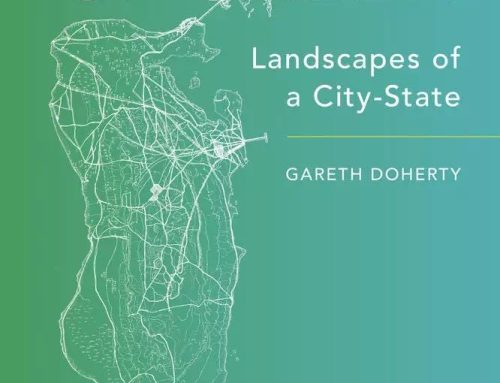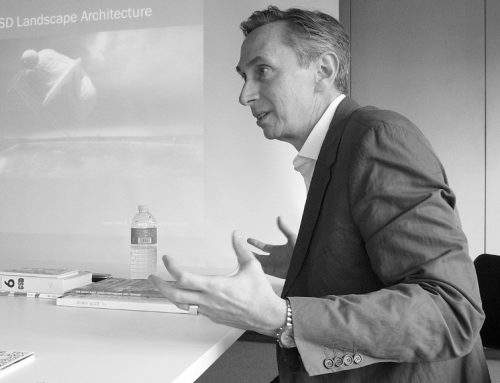林江泉
Author:Gareth Doherty,Charles Waldheim
Publisher:Routledge
Publication Date:2016
ISBN:978-1-138-01847-1
《何谓景观?》一书是以思想的外化和准确的想象能动性组织起来的结果,其引导景观设计师暂时忘记或摆脱景观设计师的角色,从多个学科代入角色去解决景观的问题,立足于景观的另一面——多个不为景观学人所知,知之不多或以为知道却不甚了了的领地,以第二人称和他者的视角去看待景观,从而再返回到景观本体,此时的景观已经是全新的景观,或者说“是景观,也不是景观”,已经超越了景观的本身,只有替代性的思考才能使设计师在景观中投入多维度的能量,生发出全新认知层面的意义。这种学科之间持续的交叉繁殖是打破文明发展瓶颈的有效方式。
景观究竟始于景观之内还是景观之外?是止于其中心还是外围?还是这些关于“之间”区分正在消失?对《何谓景观?》一书而言,景观存在与万物之中。景观学科之外的任何一个学科的起点,都能以景观的系统性思维来理解与剖析,让人在“换景”中迷路并沉迷其中。而《何谓景观?》给我们带来更大的启示是不确定性(indeterminacy):在讨论景观的时候,“景观”甚至可以不出现在其中,你还可以对“景观”原有的概念做出否定。《何谓景观?》会引发我们思考:为什么在历史上的某一时刻我们会被需要驱使从而建立一个新的学科?本书为我们打开了一种永远会持续下去的研究方向。
建筑师将造园和生态引入室内;Olafur Eliasson将家乡冰岛的大量河床、石头及水空运到了丹麦并在丹麦美术馆里举办展览。跟那些虽然持久但也许更脆弱的建筑模型相比,景观自身具有灵活性和不断陌生化的特征。多年来,笔者作为城市学者和建筑师一直以建筑为主体,链接经济学、当代艺术、电影和文学之间的交叉研究和实践,为的就是寻找建筑中的“景观弹性空间”或者景观概念取代作为城市发展单元的建筑,我们研究小组的宣言是:“我从不跨界。我是取消界线的——以建筑为基点来取消学科间的界线,名曰:消界。”景观不是终极表现,而是中间表现,探讨“之间”关系的景观是连接现实与理想的卡拉特拉瓦式拉索桥,也同样借助生态学的定义——一种作为物种与其栖息地之间关系的科学研究——以应用于更广泛的领域。景观是开始的建筑,也归来的建筑。只有动身没有归来的勒·柯布西耶于1965年离开了小木屋沿着马丁角游向了大海深处,最终他也走向了自己。当笔者读到《何谓景观? ——探讨景观特征的文集》(Is Landscape …? Essays on the Identity of Landscape)一书对学科界限的消解时,认知产生了震颤,在一扇窗中看到了门的哲学全然曝光。当我在教室里看到Gareth Doherty教授拿着中国景观领域译者陈崇贤与夏宇的中文译本《何谓景观?》时,我心里充满了热切的渴望,急迫地想阅读中文世界中的 《何谓景观?》 ,想体验汉语中的Gareth Doherty和Charles Waldheim。
《何谓景观?》一书,搜集了大量且多样的景观特征,并提出,与其为“景观”这一词汇寻找一个单一的或本质的解释,不如拓宽学科和专业领域,将这一词汇与它的同源词汇相互联系,反而能更加深入地理解该词的涵义。本书诞生于对“景观”这一词汇产生源头的探寻,展现了多位先锋学者对于景观的当代解读——在本书中,景观可以是建筑、生态、基础设施、历史、文学、艺术、哲学、社会、人文科学、人类学、生活等等,以创造出进一步移植的动力,规避了保守的现实所带来滞后的风险。景观作为一种模式,开始成为可被诸多知识、学科领域理解的一种表现语汇。景观作为一种在表现形式上发挥作用的认识论框架,与当代学科均相互关联,创造了一种路易斯·康在迈向均质空间中,词与物的一一对应和一多对应的景观。万物都能用时间与空间来描述,而时间和空间正式景观的两个维度。《何谓景观?》所带来的空间让我们得以在“时间差”中散步,也使我们得以在现实场景中直接穿行。很多杰出的公共建筑瓦解了人类所困顿的三维世界,把立体变成平面是建筑师所致力的一个方向,而景观的公共与私密是更为广泛的。《何谓景观?》以漂移的图解把城市固有的结构打散,用全景的视觉抵抗“规驯化”的城市,让民众时时刻刻在日常片段中感受流动性,也使人对城市的认知发生了变化。当代景观由此被视为一种城市模式、不同领域之间的媒介,以及一种提升公共认可和公众参与的语言工具。
语言改变世界,景观是人类的高等语言程序,这种语言从设计的角度出发,又能将其语码深入浅出。《何谓景观?》与多学科互为关系后,在“景观”一词的原初含义上不断做出修改或修订,也是对勇于对语言和逻辑的背叛——众所周知,景观设计师最初的工作并不是设计园林风景,读了《何谓景观?》你会发现,景观设计师最初的职责也不是对整个城市进行规划或设计城市的形态;而是对整个社会的方方方面在时空逻辑中进行侵入式的渗透,比如一个已经落地的景观设计项目可以看作是一篇对社会批判的论文,也可以是看作一项政制建设的任务。
很多约定俗成的认知早已“积非成是”,《何谓景观?》对待“景观”一词的态度却很开放。当你读完《何谓景观?》,你会发现,“景观”一词已经是一个新词,已经不是你过去认知中的“景观”了,毋容置疑,Gareth Doherty和Charles Waldheim教授通过《何谓景观?》一书的论文式编辑法更新了“景观”的意涵,换言之,他们给我带来了“新词”,更重要的是,他们的“新词”带来了新的语码和语法,让我们从多种视点出发来看“景观”,这个“景观”包括以人为单位,在进入现象学区域时,人的内部和外部的景观,还有内与外之间的过渡景观。编著的作者发挥了教育者的本色,他们似乎通过“景观”一词在教我们“重新识字”,并对景观含义作出修改或重新命名。更重要的是,作者帮助我们认识到景观学科的重要性:与其他学科一起,景观学科是有能力定义更广泛围的话题的,或者说,景观是没有边界的学科。景观与其他学科要进入一种无处不在又难以察觉、似曾相识又不可名状的交叉状态,才能生产出有价值的思想产品,并在研究里做出不合常规的突破。
编著中的编辑工作并非只是技术活,而是一种思想创作。《何谓景观?》的作者为我们展现了思考的灵光,把景观思想变成话语结构和思想结构。当代景观由当代景观设计史写作的方式而发展的景观史,基本上是在每一个阶段对前一个阶段的否定而体现它的价值,并且作品必须要有(留下)一种观念阐释的回旋之地和意义的褶皱,这种阐释并非解读,而是景观创作与实践的必要性参与。在这个意义上,《何谓景观?》不只是著作,也是景观的实践。每一个阶段对前一个阶段的否定是一个漫长的思考的过程。很多景观建筑师进入景观的首步不是现场、植物和劳作,而是写札记,他们通过了多年的时间通过写作、记录、发信息来让自己进入当代景观,有些欧洲的建筑师甚至远离建筑实践,以文字存世。如此看来,《何谓景观?》的编著是一项很重要的“景观设计实践”,本书提出实践者想到却没做到的地方;提出实践者没有想到的其他可能性;完成景观建筑师无法做到的事情,这些层面都进一步增加了话语权的分量,并以足够的空间和研究对象达成相互匹配的批判关系。无疑,本书与实践者、建筑师和景观设计师站在同一条战线上。而这项关于城市形态的景观实践并非由设计所决定,而是通过新兴生态的自我调节过程形成的。也就是,景观施工完成后才是设计的开始——景观最终的形态随着与社会、政治和文化相关的生态过程不断发展而成的。
何谓景观?Gareth Doherty和Charles Waldheim以提问回答问题;也许问题尚未回答,已有答案。
The thesis type editing unfolds the depth of field of a word
— Review on Is Landscape…? Essays on the Identity of Landscape
Lin Jiang Quan
Author:Gareth Doherty,Charles Waldheim
Publisher:Routledge
Publication Date:2016
ISBN:978-1-138-01847-1
Is Landscape…? The Book is the result of combining externalizing and accurate imaginative initiative thinking. It guides the landscape architects temporarily forget or get rid of the role of landscape architects and to solve the problems of the landscape from multiple disciplines in role, based on the other side of the landscape. Many unknowns to landscape economists, and few of them know or think they have known, yet is unclear in the territory. In the second person and the other’s point of view to look at the landscape, and then return to the landscape ontology. The landscape is already a new landscape, or “it is not a landscape, yet it is a landscape”, which has transcended the landscape itself. Only alternative thinking can enable designers to invest multi-dimensional energy in the landscape and generate new cognitive significance. This kind of interbreeding is an effective way to break the bottleneck of civilization development.
Architects introduce landscape and ecology into the interior; Olafur Eliasson airlifted a large number of riverbeds, rocks and water from his native Iceland to Denmark and held an exhibition in the Danish art gallery. Compared with the enduring but perhaps more fragile architectural models, landscape itself is characterized by flexibility and constant defamiliarization. Scholars and architects have been for many years. The author, as a city scholar and architect, constantly use buildings as the main body, linking economics, contemporary art, film and literature research and practice, in order to search for “landscape elastic space”, which is to replace the construction of urban development unit in architecture or landscape concept. Our team’s statement is: “I never crossover. I’m eliminating boundaries — I’m removing boundaries between disciplines based on architecture. Landscape is not the ultimate representation, but the intermediate representation. The landscape that explores the “relationship” is the calatrava drawbridge that connects reality and ideals, and is also applied to a wider range of fields by the definition of ecology, a scientific study of the relationship between species and its habitat. The landscape is architectures of the beginning as well as the return. Only le corbusier, who had left the cabin in 1965 and swam off cape Martin to the depths of the sea, eventually came to himself. When I read “what Is Landscape? (Essays on the Identity of Landscape) which deconstructs the boundaries of disciplines, my cognition vibrates and the philosophy of the door is fully exposed in a window. When I saw professor Gareth Doherty in the classroom with the Chinese translation of what is landscape? By Chen chongxian and Xia yu. At that time, I was full of eager desire, eager to read what is landscape in the Chinese world? To experience Gareth Doherty and Charles Waldheim in Chinese.
Is Landscape…? The book collects a large number of diverse features of the landscape, and proposes that, rather than seeking a single or essential explanation for the word “landscape”, it is better to broaden the disciplines and professional fields, and connect the word with its homologous vocabulary, instead, it can understand the meaning of the word more deeply. The book was born in the search of the word origin of “landscape” shows a number of pioneer scholars in the contemporary interpretation of landscape, In the book, landscape can be architecture, ecology, infrastructure, history, literature, art, philosophy, society, human science, anthropology, life, and so on, which motivate to create further transplantation, avoiding the risk of conservative reality caused by the lag. As a pattern, landscape has become an expressive vocabulary that can be understood by many knowledge and subject areas. As an epistemological framework that plays a role in the form of expression, landscape is interrelated with contemporary disciplines, creating a kind of landscape corresponding to a pair of words and objects in a homogeneous space.Everything can be described by time and space, and the two dimensions of the formal landscape are time and space. What is landscape? The space we bring allows us to walk in the “time difference” and to navigate directly through the real world.Many outstanding public buildings collapse the three-dimensional world that mankind stumbles, turning three-dimensional space into two-dimensional is the direction that architects are committed to, and the public and private concept of landscape is more extensive. What is landscape?With drifting diagrams, the inherent structure of the city is scattered, and the panoramic vision is used to resist the “regularized” city, so that people can feel the mobility in daily fragments at any time, and people’s understanding of the city has also changed.In this way, contemporary landscape is seen as a city model, a medium between different fields, and a language tool to enhance public recognition and public participation.
Language changes the world, and landscape is the higher human’s language program. From the Angle of design, this kind of language make its language code deep from the beginning and simple at the end. What is landscape?As a result, the original meaning of the word “landscape” is constantly modified or revised after mutual relations with multiple disciplines. It is also a betrayal of the courage to speak and logic.You will find that the original responsibility of a landscape architect is not to plan or design the shape of an entire city;It is an intrusive infiltration of all aspects of the whole society in the logic of time and space. For example, a landscape design project that has been implemented can be regarded as a social criticism paper or a task of political system construction.
What is landscape? The word landscape is open-mind. What is landscape?”, you will find that the word “landscape” has become a new term, which is not what you used to think of as “landscape”. There is no doubt that professor Gareth Doherty and professor Charles Waldheim adopted “what is landscape? The book’s editing method updates the implications of “landscape”. In other words, they gave me the “new words”, and more importantly, their “new words” brings new code and syntax, letting us see “landscape” through a variety of viewpoints. The word “landscape” includes human unit, and when entering the area of phenomenology, the internal and external landscape, and the transition between the inside and outside of landscape. The authors play to the essence of the pedagogue, who seem to be teaching us to “re-read” through the word “landscape” and to modify or rename the meaning of landscape. More importantly, the authors help us to recognize the importance of the landscape discipline: together with other disciplines, the landscape discipline is capable of defining a broader range of topics, or landscape is a borderless discipline. Landscape and other disciplines need to be involved in an intersecting state that is ubiquitous, undetectable, eerily familiar and indescribable to produce valuable thoughts and make unconventional breakthroughs in research.
Editing is not just a technical activity, but an ideological creation.What is landscape?The author shows us the inspiration of thinking and turns the landscape idea into discourse structure and thought structure. Contemporary landscape is the developing history of landscape, which composed by the history of contemporary landscape design. Each stage is basically the negation of the previous stage so as to reflect the value of it, and the works must have left a concept of meaning and interpretation of the land of the cyclotron fold. This interpretation is not reading, but the landscape creation and practice, the necessity of participation. In this sense, what is landscape? Not only does it is a work, but also the practice of the landscape. The denial of each stage to the previous one is a long process of thinking. The first step for many landscape architects to enter the landscape is not the site, plants and labor, but to write notes. They have spent many years writing, recording and sending messages to bring themselves into the contemporary landscape. So what is landscape? The book is a very important “landscape design practice”. The book proposes what practitioners think but fail to do.Raising other possibilities that practitioners did not expect; To accomplish what landscape architects cannot do. These layers further increase the power of discourse and achieve a matching critical relationship with the research objects through sufficient space.There is no doubt that this book is on the same side as practitioners, architects and landscape architects. This landscape practice of urban form is not determined by design, but formed through the self-regulating process of emerging ecology. In other words, after the construction of the landscape is completed, the design begins — the final form of the landscape develops continuously with the ecological process related to society, politics and culture.
Is Landscape…? Gareth Doherty and Charles Waldheim answered the question in the way of asking questions. Perhaps the question was answered in a way, though it seemed not to get an answer.






评论